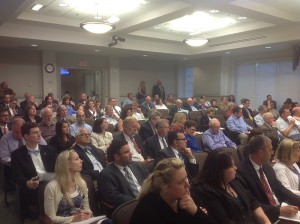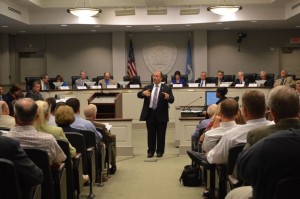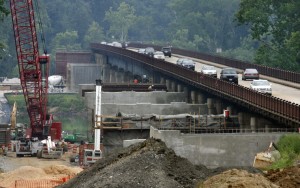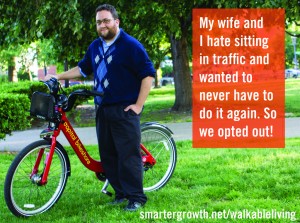 FAIRFAX, Va. – At the first of two Northern Virginia Transportation Authority public hearings Thursday, about 100 people showed up at Fairfax City’s city hall to discuss the best way to improve commutes.
FAIRFAX, Va. – At the first of two Northern Virginia Transportation Authority public hearings Thursday, about 100 people showed up at Fairfax City’s city hall to discuss the best way to improve commutes.
Specifically, the NVTA wanted to get advice on how to spend about $192.5 million that will come from new taxes in Virginia Gov. Bob McDonnell’s transportation package, which takes effect July 1.
“While we want to work quickly, we also want to make sure we spend these dollars wisely,” said NVTA Chairman Martin Nohe, who also serves on the Prince William County Board of Supervisors.
The authority released a long list of projects, broken down into six corridors, with detailed descriptions of costs and congestion relief projections.
Delegate Jim LeMunyon, a Republican who represents part of Fairfax and Loudoun counties, handed out maps to NVTA members with red, yellow and green lines to describe congestion in Northern Virginia.
“In my view, the priority of the authority is to get the red off the map. It’s as simple as that,” he said.
But Stewart Schwartz, executive director of the Coalition for Smarter Growth, testified that LeMunyon’s approach is too focused on cars and not enough on transit.
“The misguided approach of just trying to get the red out by widening roads and adding interchanges is only going to squander our tax dollars,” he said.
Schwartz advocates policies that promote sustainable communities where people can eat, work and play in one spot. He urged NVTA members to fund mass transit options that will solve congestion problems in the long term.
Several citizens who testified seemed to agree with this approach.
“Move the rail projects to the top of the list. Give them the highest priority because they’ll do the most good for the most people,” said Alexandria resident Gail Parker.
“When you’re looking at projects that are efficient, an automobile that’s only carrying one person is not a very efficient mode of transportation,” said Fairfax City resident Douglas Stewart.
Schwartz says constantly widening roads also could convince drivers to abandon carpools and go back to single-occupancy vehicles, which he says is a bad idea.
However, several residents also pointed to Route 28 projects as a good use of transportation dollars.
“Route 28 connects western Prince William to Fairfax and Loudoun and there are several shovel-ready projects that are just awaiting money and could help with congestion relief,” said Nohe.
Kerry O’Brien of Fairfax County is familiar with traffic on the roadway.
“Route 28 is severely congested during the rush hours now. Relief is needed now. It’s not needed in 2035, it’s needed now,” he said.
Jeff Fairfield of the Route 28 Station – South Study Working Group applauded the efforts.
“These projects are shovel-ready. The final designs are ready. The right-of-way has been secured. The construction contracts are ready to go,” he said.
But Jeanine Lawson of Prince William County urged caution.
“I ask you to closely scrutinize the project for widening Route 28 from Linton Hall Road to Fitzwater Drive. That road is on the border of Fauquier County, which isn’t covered in this tax, so I question why you’d do it. The money would be better spent in the Yorkshire section,” she said.
Lawson was referring to a particularly congested stretch of Route 28 on the Prince William County and Fairfax County border between Manassas and Centreville.
Nohe believes both the Linton Hall Road and Yorkshire projects could get money this year.
Currently, the list contains 12 road and 21 transit projects. LeMunyon wants NVTA members to reduce the list to three or four, but Nohe tells WTOP he thinks the final approval list will have 10 to 15 projects.
The NVTA will hold a second public hearing on July 24 at 6 p.m. at Fairfax City’s city hall, then hold a meeting where a few projects could get the green light.
Two more open houses will be held next week:
- Fairfax County
Date: June 26th
Time: 7:00 p.m.
Location: Fairfax County Government Center, 12000 Government Center Parkway, Rooms 4/5, Fairfax, Virginia. - Arlington County
Date: June 27, 2013
Time: 6:00 pm
Location: Arlington County Board Room 300, 2100 Clarendon Boulevard Arlington, Virginia 22201
Photo courtesy of WTOP/Ari Ashe.
Click here to read the original story>>






















